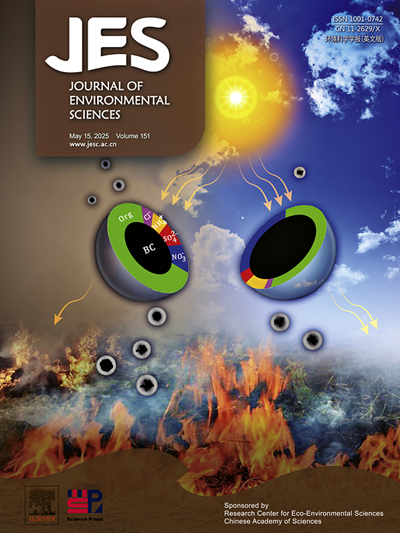父代双酚 A 暴露会改变珍稀鲦鱼(Gobiocypris rarus)后代的颅面软骨发育
IF 6.3
2区 环境科学与生态学
Q1 ENVIRONMENTAL SCIENCES
引用次数: 0
摘要
双酚A (BPA)是一种公认的雌性内分泌干扰物,对鱼类的生殖健康构成威胁。然而,目前尚不清楚父亲的BPA暴露是否以及如何导致后代的发育毒性。为了探讨雄性双酚a暴露对后代颅面软骨生长的潜在影响,将雄性稀有鲦鱼置于双酚a环境中,随后与正常雌性交配以产生后代。我们的研究结果表明,父亲BPA暴露导致F1后代畸形增加和颅面软骨发育延迟。此外,BPA暴露导致F0代父本精子中28种mirna的差异表达(13种上调,15种下调),其中7种mirna参与骨发育的调控。BPA在F1胚胎发育过程中也下调了bmp2a和Runx1的表达。由于bmp2a是BPA的靶基因之一,因此bmp2a的表达受到抑制可能源于BPA对其中一种miRNA aca-miR-16a-5P的刺激。值得注意的是,父本BPA暴露不影响F2代的颅面软骨发育或性腺发育。总之,我们的研究揭示了父亲双酚a暴露对后代面部软骨形成影响的分子机制,为鱼类种群的生态保护提供了理论支持。本文章由计算机程序翻译,如有差异,请以英文原文为准。

Paternal bisphenol A exposure alters craniofacial cartilage development in rare minnow (Gobiocypris rarus) descendants
Bisphenol A (BPA) is a recognized estrogenic endocrine disruptor that poses a threat to the reproductive health of fish. However, it remains unclear whether and how paternal BPA exposure can lead to developmental toxicity in offspring. To explore the potential paternal BPA exposure impacts on craniofacial cartilage growth in offspring, male rare minnows were subjected to BPA and subsequently mated with normal females to produce progeny. Our results demonstrated that paternal BPA exposure resulted in increased malformation and delayed craniofacial cartilage development in the F1 offspring. Furthermore, BPA exposure led to differential expression of 28 miRNAs in paternal sperm in F0 generation (13 upregulated and 15 downregulated), among which 7 miRNAs were involved in the regulation of bone development. BPA also downregulated the expression of bmp2a and Runx1 during F1 embryonic development. The inhibited bmp2a expression might derive from BPA's stimulation of one miRNA, aca-miR-16a-5P, due to bmp2a being one of its target genes. Notably, paternal BPA exposure did not affect craniofacial cartilage development or gonadal development in the F2 generation. Overall, our study sheds light on the molecular mechanisms underlying the impact of paternal BPA exposure on facial chondrogenesis in offspring and provides theoretical support for the ecological protection of fish populations.
求助全文
通过发布文献求助,成功后即可免费获取论文全文。
去求助
来源期刊

Journal of Environmental Sciences-china
环境科学-环境科学
CiteScore
13.70
自引率
0.00%
发文量
6354
审稿时长
2.6 months
期刊介绍:
The Journal of Environmental Sciences is an international journal started in 1989. The journal is devoted to publish original, peer-reviewed research papers on main aspects of environmental sciences, such as environmental chemistry, environmental biology, ecology, geosciences and environmental physics. Appropriate subjects include basic and applied research on atmospheric, terrestrial and aquatic environments, pollution control and abatement technology, conservation of natural resources, environmental health and toxicology. Announcements of international environmental science meetings and other recent information are also included.
 求助内容:
求助内容: 应助结果提醒方式:
应助结果提醒方式:


